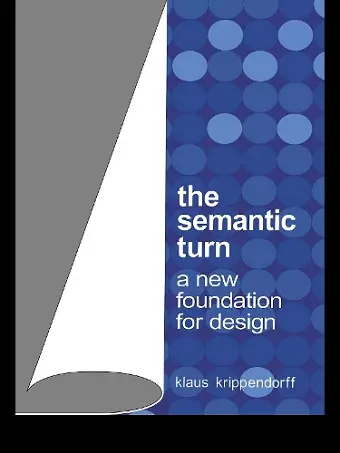The Semantic Turn
A New Foundation for Design
Format:Hardback
Publisher:Taylor & Francis Ltd
Published:21st Dec '05
Currently unavailable, and unfortunately no date known when it will be back

Responding to cultural demands for meaning, user-friendliness, and fun as well as the opportunities of the emerging information society, The Semantic Turn boldly outlines a new science for design that gives designers previously unavailable grounds on which to state their claims and validate their designs. It sets the stage by reviewing the history of semantic concerns in design, presenting their philosophical roots, examining the new social and technological challenges that professional designers are facing, and offering distinctions among contemporary artifacts that challenge designers.
Written by Klaus Krippendorff, recognized designer and distinguished scholar of communication and language use, the book builds an epistemological bridge between language/communication theory and human-centered conceptions of contemporary artifacts. Clarifying how the semantic turn goes beyond product semantics and differs from other approaches to meaning, Krippendorff develops four new theories of how artifacts make sense and presents a series of meaning-sensitive design methods, illustrated by examples, and evaluative techniques that radically depart from the functionalist and technology-centered tradition in design.
An indispensable guide for the future of the design profession, this book outlines not only a science for design that encourages asking and answering new kinds of questions, it also provides concepts and a vocabulary that enables designers to better partner with the more traditional disciplines of engineering, ergonomics, ecology, cognitive science, information technology, management, and marketing.
“A brilliant book so superbly designed, encompassing theory and application. Klaus Krippendorff demonstrates his authority in the semantics of design with a bold inter-disciplinary approach. The book unveils a systematic design discourse, treating readers to rare critiques of established ideas and illustrative reviews of design cases. …it must be read by designers and non-designers alike.”
-- Professor Halimahtun M. Khalid, Director, Institute of Design and Ergonomics Applications, University of Malaysia
“An important contribution of philosophical discussion about design, the meaning of artifacts, and interesting topics concerning the “science of design” and design methods are offered … I recommended this book to all professionals and student involved in design and evaluation of interfaces … the author provides a foundation for a more in-depth understanding of user-centered design, especially artifacts.”
— Abas Moallem, in HCI International News, No. 15, March 2006
“… the linguistic turn in philosophy he thoughtfully outlines a convincing teachable doctrine on how to make sense of things. … This book, itself an artifact, deserves a prominent place in any design canon … also strongly recommended it to academic colleagues, students, and practitioners. … will get its genuine meaning in use, it is hoped by reaching a broad network of stakeholders …”
— Pelle Ehn, School of Arts and Communication Malmo University, Sweden, in Artifact, Vol. 1, 2006
“…a major contribution to design thinking. Klaus Krippendorff's philosophy addresses how we create and use artifacts in view of the meanings we give them. It builds a human and systematic foundation for professional design practice based on creative engagement with users and stakeholders. Krippendorff’s intellectual journey reflects the central themes in design and design research today, helping new designers think their way into the field. …”
-- Professor Ken Friedman, Norwegian School of Management and Denmark's Design School
“…a courageous outline for a concrete science for design that paradigmatically deviates from the natural sciences. It…offers designers a solid ground from which to justify their products and environments...proposes systematically human-centered design methods, and an epistemology for improving the world rather than re-searching it. …a major step into a fascinating future for all of us.”
-- Professor Emeritus Shutaro Mukai, Former Director, Department of Science of Design, Musahino Art University, Tokyo, Japan
“…takes design theory to a new level…Brilliantly building on Wittgenstein and generalizing classical accounts of affordances…This highly readable book is especially relevant to the challenges we face in designing in and for a global economy.”
-- John Seely Brown, Former Chief Scientist, Xerox Corporation & Director of its Palo Alto Research Center (PARC)
“… to formulate and describe scientifically he outlines a method that has changed noticeably in design theory since the 1980s. … encourages disciplinary discourse and creates fundamental new foundations of a science for design, which continues to suffer from the empty gossip about its inter-, trasn- and multidisciplinary nature. …”
— In Books, Form 209/2006
ISBN: 9780415322201
Dimensions: unknown
Weight: 700g
368 pages